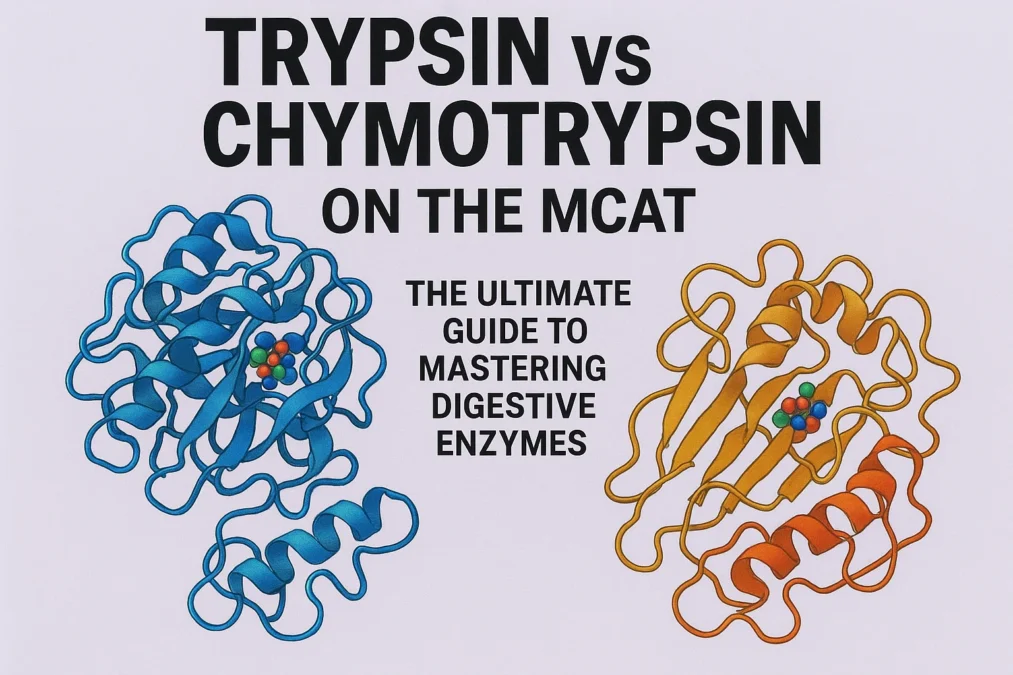Trypsin vs Chymotrypsin on the MCAT: Welcome, future physician! You’re deep in your MCAT preparation, and you’ve undoubtedly encountered the dynamic duo of the digestive system: trypsin and chymotrypsin. These two enzymes are stars in the world of biochemistry and are absolute favorites of the MCAT test-makers. Understanding them isn’t just about memorizing a couple of names; it’s about grasping a fundamental concept in protein digestion, enzyme specificity, and physiological regulation. Many students find themselves mixing up their roles, their triggers, and their specificities. But don’t worry, that’s exactly why we’re here.
This comprehensive guide is designed to be your one-stop resource for everything you need to know about trypsin and chymotrypsin for the MCAT. We will go far beyond a simple definition. We’ll dive into their intricate mechanisms, explore their unique specificities in vivid detail, and place them within the larger context of the digestive cascade. We’ll break down exactly why the AAMC loves to test this comparison and, most importantly, equip you with the knowledge and strategies to answer any related question with confidence. So, grab your favorite highlighter, and let’s demystify these critical proteolytic enzymes together.
Understanding the Big Picture: Proteolytic Enzymes and Protein Digestion
Before we can effectively compare our two main characters, we need to set the stage. Proteins are fundamental macromolecules, built from long chains of amino acids linked by peptide bonds. For your body to absorb and utilize these amino acids, the massive protein structures from your food must be broken down into much smaller dipeptides, tripeptides, and single amino acids. This monumental task falls to a specialized group of enzymes known as proteases or peptidases.
Trypsin and chymotrypsin belong to a specific family of proteases called serine proteases. This name is a huge clue to their mechanism. The “serine” refers to a critical serine amino acid residue within the enzyme’s active site that plays a direct role in catalyzing the cleavage of peptide bonds. They are termed endopeptidases because they hydrolyze peptide bonds within the interior of a polypeptide chain, not at the ends. This is in contrast to exopeptidases, which nibble away at the terminal ends. The action of endopeptidases like trypsin and chymotrypsin is crucial because it breaks large proteins into smaller fragments, dramatically increasing the number of ends available for exopeptidases to act upon, thereby maximizing digestion efficiency.
This entire digestive process is a beautifully orchestrated cascade, especially in the duodenum (the first part of the small intestine). It begins with the release of the hormone cholecystokinin (CCK) in response to the presence of peptides and amino acids in the duodenum. CCK then stimulates the pancreas to secrete a fluid filled with digestive enzyme zymogens—inactive precursors of enzymes. Using inactive precursors is a vital protective mechanism; it prevents the pancreas from digesting itself. These zymogens only become activated once they reach the small intestine, triggered by specific enzymatic cleavages. This is the world that trypsin and chymotrypsin operate in, and understanding this regulatory hierarchy is key to mastering their function for the MCAT.
Diving Deep into Trypsin: The Primary Activator
Let’s meet our first enzyme: trypsin. If the digestive cascade had a leader, it would be trypsin. Its role extends beyond just cutting up dietary proteins; it is the master switch that activates nearly all the other digestive pancreatic zymogens. Trypsin itself is secreted by the pancreas as its inactive form, trypsinogen. So, how does the first domino fall? The key is an enzyme called enteropeptidase (formerly known as enterokinase), which is embedded in the lining of the duodenum.
Enteropeptidase performs the initial, critical activation. It cleaves a small peptide off the N-terminus of trypsinogen, converting it into active trypsin. Once a small amount of trypsin is formed, it takes over in a powerful positive feedback loop. Trypsin can cleave and activate more trypsinogen, amplifying its own production rapidly. More importantly, it activates the other zymogens: chymotrypsinogen becomes chymotrypsin, proelastase becomes elastase, and procarboxypeptidase becomes carboxypeptidase. This makes trypsin the linchpin of the entire proteolytic digestive system. Without trypsin activation, the other enzymes remain dormant.
Now, for its digestive job: what does trypsin actually cut? Trypsin is famous for its specificity. It hydrolyzes peptide bonds where the carbonyl group (C=O) is contributed by a basic amino acid—either lysine or arginine. Think of it as a molecular pair of scissors that only cuts after a positively charged amino acid. This specificity arises from the structure of its active site, which contains an aspartic acid residue that forms a “specificity pocket.” This pocket has a negatively charged carboxylate group (-COO⁻) that attracts and snugly fits the positively charged side chains of Arg and Lys, positioning the adjacent peptide bond perfectly for cleavage. Recognizing this specificity is a high-yield MCAT concept.
Pantoprazole vs Omeprazole: A Comprehensive Comparison
Diving Deep into Chymotrypsin: The Aromatic Specialist
Next up is chymotrypsin. While trypsin is the general and activator, chymotrypsin is a specialized soldier, called upon to cleave in very specific locations. Like trypsin, it is a serine protease secreted by the pancreas as an inactive zymogen, in this case called chymotrypsinogen. It cannot activate itself; it relies entirely on our master regulator, trypsin, for its activation. Trypsin cleaves two specific peptide bonds within chymotrypsinogen, leading to the formation of the active π-chymotrypsin, which then undergoes further autocatalytic processing to become the stable, active form, α-chymotrypsin.
The magic of chymotrypsin lies in its unique specificity. It prefers to hydrolyze peptide bonds where the carbonyl group is contributed by an amino acid with a large, hydrophobic aromatic ring. Its primary targets are phenylalanine, tryptophan, and tyrosine. A helpful mnemonic to remember this is “Chymotrypsin is F’n Wicked at cutting Tyr-es” (F for Phenylalanine, W for Tryptophan, Tyr for Tyrosine). Its active site specificity pocket is a deep, hydrophobic pocket that perfectly accommodates these bulky, non-polar aromatic rings.
This complementary fit is a textbook example of enzyme-substrate specificity driven by non-covalent interactions, particularly hydrophobic effects. The benzene ring of phenylalanine, for instance, is stabilized in this hydrophobic environment, orienting the scissile peptide bond for nucleophilic attack. It’s worth noting that chymotrypsin can also cleave after other hydrophobic residues like methionine or leucine, but with a much lower efficiency. For the MCAT, you should firmly associate chymotrypsin with Phe, Trp, and Tyr. This clear distinction from trypsin’s specificity is a common point of testing.
The Head-to-Head Comparison: Trypsin vs Chymotrypsin
Now that we have a solid individual understanding, let’s place them side-by-side. While they are both pancreatic serine endopeptidases, a direct comparison reveals their critical differences and highlights why the AAMC finds this topic so compelling. The core of the trypsin vs chymotrypsin comparison lies in their specificity, their role in the activation cascade, and the nuances of their mechanisms.
The most fundamental difference is the type of peptide bond they cleave. As established, trypsin cuts after the basic, positively charged amino acids Lys and Arg. Chymotrypsin, on the other hand, cuts after the bulky, hydrophobic, aromatic amino acids Phe, Trp, and Tyr. This is the number one fact to sear into your memory. Furthermore, their roles in the digestive cascade are hierarchically different. Trypsin holds a superior position as the key activator enzyme. It is the only one activated by an external trigger (enteropeptidase) and it subsequently activates itself (autocatalysis) and all other zymogens, including chymotrypsinogen. Chymotrypsin has no such activating function; it is a pure digestive workhorse, activated by and dependent on trypsin.
Despite their different specificities, they share the same core catalytic mechanism because they are both serine proteases. This mechanism involves a catalytic triad of three amino acids—Aspartate, Histidine, and Serine (the namesake). The process involves a nucleophilic attack by the serine’s -OH group on the carbonyl carbon of the peptide bond, forming a transient tetrahedral intermediate and then an acyl-enzyme intermediate, followed by hydrolysis. Understanding this general mechanism is high-yield for the MCAT, as it applies to this entire enzyme family.
| Feature | Trypsin | Chymotrypsin |
|---|---|---|
| Zymogen (Inactive Form) | Trypsinogen | Chymotrypsinogen |
| Activator | Enteropeptidase (then autocatalysis) | Trypsin |
| Primary Specificity | Cleaves after Lysine (Lys/K) and Arginine (Arg/R) | Cleaves after Phenylalanine (Phe/F), Tryptophan (Trp/W), Tyrosine (Tyr/Y) |
| Key Chemical Property of Target | Positively charged (basic) side chains | Bulky, hydrophobic, aromatic rings |
| Role in Cascade | Master activator (activates itself, chymotrypsin, elastase, carboxypeptidase) | Digestive enzyme (activated by trypsin) |
| Specificity Pocket | Negatively charged (aspartate) | Deep, hydrophobic pocket |
Why This Distinction is Crucial for the MCAT
You might be wondering why the test-makers are so obsessed with this particular comparison. The reason is that the trypsin vs chymotrypsin topic is a perfect vehicle for testing a wide range of foundational scientific concepts all at once. It’s not just rote memorization; it’s about application and integration. First and foremost, it tests your understanding of enzyme specificity. The AAMC loves to present a peptide sequence and ask which bonds would be cleaved by trypsin, chymotrypsin, or both. Getting these questions right requires instant recall of their specificities and the ability to apply that knowledge to a novel sequence.
Furthermore, this topic is a gateway to testing broader principles in biochemistry. The activation cascade is a classic example of a biochemical amplification pathway and zymeogen regulation, crucial concepts for understanding how the body controls powerful processes like digestion and blood clotting. The shared catalytic mechanism of serine proteases allows test-writers to ask about transition states, enzyme kinetics (Michaelis-Menten), and the role of specific amino acids in catalysis (e.g., what happens if the catalytic serine is mutated?).
Finally, it integrates with biology content areas like human physiology. Understanding where these enzymes are produced (pancreas), where they are active (duodenum), and how their secretion is regulated (by hormones like CCK) demonstrates a systems-level understanding of the human body. An MCAT question might link a pathology like pancreatitis (inflammation of the pancreas) to the premature activation of these zymogens, testing your ability to apply basic science knowledge to a medical scenario.
Mastering MCAT Questions on Trypsin and Chymotrypsin
So, how do you translate this knowledge into correct answers on test day? The most common question type is the peptide cleavage problem. You will be given a string of amino acids (e.g., Ala-Val-Phe-Arg-Gly-Ser-Lys-Leu) and asked what fragments would result from treatment with trypsin. Your strategy should be: 1) Scan the sequence for Lys (K) or Arg (R). 2) Mentally cut after each of these residues. Remember, the enzyme cuts the peptide bond on the carboxyl side of its target amino acid.
For chymotrypsin, you follow the same process but scan for Phe (F), Trp (W), or Tyr (Y). It is critical to remember that these enzymes are endopeptidases; they create new C-termini and N-termini within the chain. Also, note that if the target amino acid is at the very end of a chain (the C-terminus), there is no peptide bond after it to cleave. Another common trick is to ask about the number of fragments produced. For example, a peptide with two lysine residues will be cut by trypsin into three fragments.
Be prepared for experimental passages that describe modifications to these enzymes. For instance, if a researcher mutates the aspartate in trypsin’s specificity pocket to a neutral amino acid, how would that affect its function? The answer is that it would likely lose its specificity for basic residues because it can no longer form the stabilizing ionic bond. Understanding the “why” behind the specificity makes you immune to these tricky application questions. Always link structure to function.
Beyond Trypsin and Chymotrypsin: The Protease Family
While trypsin and chymotrypsin are the headliners, the MCAT expects you to know about their close relatives to have a complete picture. The other major pancreatic serine protease is elastase. As its name implies, it specializes in digesting elastin, a fibrous protein in connective tissues. Its specificity is for small, neutral amino acids like alanine, glycine, and valine. Its specificity pocket is shallow and lined with uncharged amino acids, allowing these smaller side chains to fit.
Then there are the exopeptidases, which complete the job started by the endopeptidases. Carboxypeptidase A (a zinc-containing metalloenzyme) is activated by trypsin and cleaves off aromatic and branched-chain amino acids from the C-terminus of peptides. Carboxypeptidase B prefers to cleave basic amino acids (Arg, Lys) from the C-terminus. On the other end of the chain, aminopeptidases cleave amino acids from the N-terminus. This combined action of endo- and exopeptidases ensures proteins are fully digested into absorbable units.
It’s also valuable to be aware of other proteases outside the gut. For example, thrombin is a serine protease crucial in the blood clotting cascade, and it has a trypsin-like specificity (cleaving after Arg). Caspases are cysteine proteases that are key executors of apoptosis (programmed cell death). Recognizing that the serine protease mechanism is a common and evolutionarily conserved catalytic strategy can help you tackle unfamiliar passages on the exam.
Common Mistakes and How to Avoid Them
Even the most prepared students can stumble on these concepts if they fall into common traps. The biggest mistake is confusing the specificities. Mixing up which enzyme cuts after which amino acid is a sure way to lose easy points. Drill this until it becomes second nature. Use mnemonics, flashcards, or simply draw out the structures of Lys/Arg (basic) and Phe/Trp/Tyr (aromatic) repeatedly.
Another frequent error is misidentifying the site of cleavage. Remember, the enzyme hydrolyzes the peptide bond immediately after (on the carboxyl side of) its target amino acid. The target amino acid will become the new C-terminus of one fragment. For example, cutting Ala-Phe-Arg-Gly with trypsin cleaves after Arg, producing Ala-Phe-Arg and Gly.
Students also sometimes confuse the activators. Remember that enteropeptidase is only for trypsinogen. Chymotrypsinogen is activated only by trypsin. There is no enteropeptidase for chymotrypsin. Finally, avoid overcomplicating things. The MCAT will typically test the primary, high-yield specificities. While chymotrypsin can occasionally cut after other residues, for all practical MCAT purposes, stick with Phe, Trp, and Tyr unless a passage explicitly states otherwise.
Conclusion
In the grand saga of MCAT biochemistry, the story of trypsin vs chymotrypsin is a crucial chapter. These two enzymes exemplify the elegant precision of biological systems: specialized functions, intricate regulation through zymogen activation cascades, and exquisite enzyme-substrate specificity driven by complementary molecular structures. Trypsin, the master activator with a preference for basic residues, and chymotrypsin, the aromatic specialist, work in concert to dismantle dietary proteins into their building blocks.
Mastering this comparison means more than just memorizing two lists of amino acids. It means understanding a fundamental physiological process, a classic enzymatic mechanism, and a key regulatory strategy—all of which are prime targets for the MCAT. By internalizing their differences in activation, specificity, and role, you arm yourself with the knowledge to dismantle any related exam question as efficiently as these enzymes dismantle a protein. So, the next time you see a peptide sequence, you’ll know exactly what to do. You’ll scan for Lys and Arg for trypsin, spot Phe, Trp, and Tyr for chymotrypsin, and confidently predict the fragments, knowing you’ve mastered a high-yield topic that brings you one step closer to your medical school goals.
Frequently Asked Questions (FAQ)
What is the main difference between trypsin and chymotrypsin?
The main difference lies in their specificity—the type of peptide bonds they hydrolyze. Trypsin cleaves after the basic amino acids lysine and arginine. Chymotrypsin cleaves after the bulky, hydrophobic, aromatic amino acids phenylalanine, tryptophan, and tyrosine. This difference is dictated by the unique structure of each enzyme’s active site specificity pocket.
How are trypsin and chymotrypsin activated?
They are both activated from their inactive zymogen forms through proteolytic cleavage. Trypsinogen (the zymogen of trypsin) is activated by the enzyme enteropeptidase, which is located on the brush border of the duodenum. Once a small amount of trypsin is active, it activates more trypsinogen (autocatalysis). Chymotrypsinogen (the zymogen of chymotrypsin) is activated exclusively by trypsin. This makes trypsin the master activator in the pancreatic protease cascade.
Why are they called serine proteases?
Trypsin and chymotrypsin are called serine proteases because their catalytic mechanism relies on a key serine residue in their active site. This serine, along with a histidine and an aspartate residue, forms a “catalytic triad.” The serine’s hydroxyl group (-OH) acts as a nucleophile, directly attacking the carbonyl carbon of the peptide bond to be hydrolyzed, making it essential for their function.
Can trypsin and chymotrypsin digest each other?
This is a fantastic question that tests deep understanding. Yes, they potentially can, because they are proteases. Trypsin could cleave chymotrypsin after any lysine or arginine residues present in its structure, and chymotrypsin could cleave trypsin after any phenylalanine, tryptophan, or tyrosine residues. This is precisely why they are synthesized and secreted as inactive zymogens—to prevent them from digesting the pancreas itself and each other before they reach the duodenum.
What would happen if trypsin failed to be activated?
If trypsin activation failed (e.g., due to an enteropeptidase deficiency), the entire pancreatic protease cascade would grind to a halt. Without active trypsin, there would be no activation of chymotrypsinogen, proelastase, or procarboxypeptidase. This would lead to severely impaired protein digestion, malabsorption, diarrhea, and nutrient deficiencies because proteins would pass through the digestive tract largely undigested. This highlights trypsin’s critical role as the central activator.



